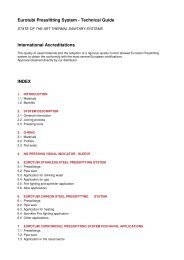corrosion of stainless steel - Damstahl
corrosion of stainless steel - Damstahl
corrosion of stainless steel - Damstahl
You also want an ePaper? Increase the reach of your titles
YUMPU automatically turns print PDFs into web optimized ePapers that Google loves.
Chapter 6 - Corrosion <strong>of</strong> Stainless Steel<br />
EN AISI / UNS / Popular Name Cr Mo N PREN<br />
1.4034 AISI 440B 14.0 0.5 - 15.7<br />
1.4057 AISI 431 15.0 - - 15.0<br />
1.4542 AISI 630 15.0 - - 15.0<br />
2.4816 Inconel 600 14.0 - - 14.0<br />
1.4021 AISI 420 12.0 - - 12.0<br />
1.4003 AISI 410S 11.5 - - 11.5<br />
1.4006 AISI 410 11.5 - - 11.5<br />
1.4512 AISI 409 10.5 - - 10.5<br />
Table 6.1:<br />
List <strong>of</strong> the content <strong>of</strong> Cr, Mo and N in a range <strong>of</strong> standard <strong>stainless</strong> <strong>steel</strong><br />
and the calculated PREN according to Eq. 6.1. For all types <strong>of</strong> <strong>steel</strong> the<br />
values for Cr, Mo and N are minimum values according to the standards<br />
(see Chapter 8). The colour <strong>of</strong> the dots indicates <strong>steel</strong> type: Austenitic (red),<br />
ferritic (blue), duplex (green), pH alloys (yellow), martensitic (purple) and<br />
nickel alloys, austenitic (black).<br />
Again it helps to regard <strong>stainless</strong> <strong>steel</strong> as a fishing line. If so, PREN can be<br />
regarded as the fishing line's breaking strength, and the higher the breaking<br />
strength, the smaller the risk that the line will break at a given load. In<br />
principle, choosing <strong>stainless</strong> <strong>steel</strong> is therefore 'just' a question <strong>of</strong> finding a<br />
<strong>steel</strong> with a sufficiently high 'breaking strength' towards <strong>corrosion</strong>.<br />
Unfortunately, a higher level <strong>of</strong> useful alloying elements also entails<br />
a significantly higher price and usually also increased processing costs.<br />
The solution to the problem is therefore not to build everything using 254<br />
SMO or super duplex, but to find a suitable balance in between <strong>corrosion</strong><br />
resistance and price. You have to find out what is required and then you<br />
'just' have to choose <strong>steel</strong> on the right side <strong>of</strong> the limit – <strong>of</strong> course with a<br />
healthy safety margin.<br />
PREN;<br />
4301 v. 4401<br />
Take e.g. the classic 4301 (AISI 304). This type <strong>of</strong> <strong>steel</strong> contains min. 17.5% Cr<br />
and neither Mo or N which is why PREN 4301<br />
will be 17.5. The acid-resistant<br />
<strong>steel</strong>, 4401, contains only 16.5% Cr, but at the same time at least 2.0% Mo,<br />
which pushes PREN 4401<br />
up to 23.1. Just by observing the alloy composition<br />
<strong>of</strong> the two types <strong>of</strong> <strong>steel</strong>, it is possible to predict that 4401 has a better<br />
resistance to pitting <strong>corrosion</strong> than 4301. If you look at the duplex '2205'<br />
(4462), PREN 4462<br />
ends up at 30.9 as pro<strong>of</strong> <strong>of</strong> even better resistance against<br />
pitting <strong>corrosion</strong>.<br />
That PREN is not just pure invention can be seen from Figure 6.10 which<br />
shows the <strong>corrosion</strong> resistance for different types <strong>of</strong> <strong>stainless</strong> <strong>steel</strong> in<br />
different media. Note that the higher the <strong>steel</strong>'s PREN, the higher the curve<br />
for the <strong>steel</strong> concerned regardless <strong>of</strong> the chloride content <strong>of</strong> the water. Steel such<br />
as the acid-resistant 4401 is therefore better in all media than the non-acidresistant<br />
4301 <strong>steel</strong>. This does not mean that 4401 is immune to pitting<br />
<strong>corrosion</strong>, but that it takes more to initiate pitting <strong>corrosion</strong> in 4401 than<br />
for its younger brother 4301. If 4301 can keep up, so can 4401, and if 4401<br />
suffers from pitting <strong>corrosion</strong>, so will 4301.<br />
95<br />
RS for alle.indb 95<br />
9/29/2011 12:44:38 PM

















